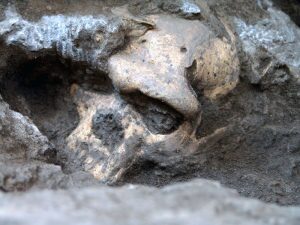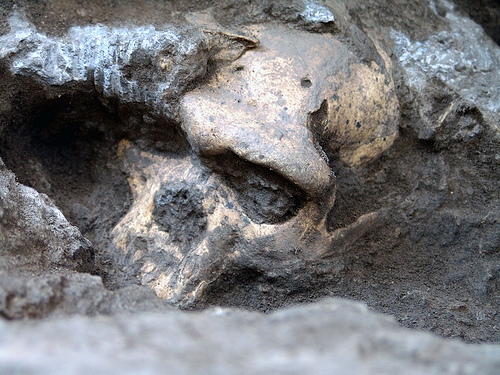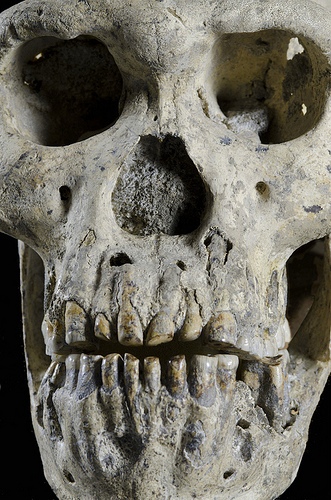
We may have to change some thinking about early human evolution in a major way, suggests researchers, after studying new fossil finds at the site of Dmanisi in the Republic of Georgia. What has previously been thought to be separate ancient human species – Homo erectus, Homo habilis, Homo rudolfensis, and Homo ergaster, for example, may actually be variations of one and the same species. This is the conclusion of a recent examination of fossil finds uncovered at this, the world’s earliest known hominid site outside of Africa.
The new report describes the analysis of a complete, approximately 1.8-million-year-old cranium that was discovered in 2005 by scientists who, 5 years earlier, uncovered its corresponding mandible (jaw) at the same location. Combined, these fossils now constitute the most complete adult ancient human ancestor skull known to be identified with the Early Pleistocene genus of Homo (the genus of great apes that includes modern humans and species closely related to them). The Early Pleistocene time period ranged between 2.588 ± 0.005 Ma (million years ago) and 0.781 ± 0.005 Ma.
The cranium and mandible, together designated as Skull 5, combines a relatively small braincase with a long face and large teeth. These two fossils were discovered alongside the remains of four other early Homo fossil finds, animal fossils, and simple stone tools. The finds included associated fossils indicating modern human-like limb proportions and body size. What makes the discoveries unique is that all of the artifacts were found in context indicating the same time period and location, providing scientists the first and best opportunity to compare physical traits among multiple human fossil specimens representing what were previously thought to be members of different species living contemporaneously.
_________________________________________________________________________________________________________
This is the Dmanisi early Homo cranium in situ. Photo courtesy of Georgian National Museum
_______________________________________________________________________________________________________
The face of Dmanisi Skull 5 (cranium and mandible together). Photo courtesy of Malkhaz Machavariani, Georgian National Museum
_______________________________________________________________________________________________________
Dmanisi Skulls 1-5 (left to right), and a Dmanisi landscape. Image courtesy of M. Ponce de León and Ch. Zollikofer, University of Zurich, Switzerland
________________________________________________________________________________________________________
After examining the remains, the research team, consisting of Dr. David Lordkipanidze from the Georgian National Museum in Tbilisi, Georgia, along with colleagues from Switzerland, Israel and the United States, concluded that the differences among these fossils vary no more than the differences between five modern humans or five chimpanzees.
“Thanks to the relatively large Dmanisi sample, we see a lot of variation,” said Christoph Zollikofer from the Anthropological Institute and Museum in Zurich, Switzerland—a co-author of the Science report. “But the amount of variation does not exceed that found in modern populations of our own species, nor in chimps and bonobos……Had the braincase and the face of Skull 5 been found as separate fossils at different sites in Africa, they might have been attributed to different species.”
Historically, variations among Homo fossil finds in Africa and Asia have also been found, but these differences have never been found within the same spatial and time period context, and thus scientists have classified the various finds as belonging to separate species. These new findings suggest that researchers need to re-adjust their thinking when determining how early Homo fossil discoveries are classified.
In the larger picture, human evolutionists have theorized that the Homo fossils discovered at Dmanisi represent ancient human ancestors that diverged from Australopithecus and then soon after dispersed from Africa. The significance of Skull 5 suggests that, during the early Pleistocene, rather than several different Homo species, a single Homo species (Homo erectus), capable of coping with a variety of ecosystems, emerged from Africa.
The report is published in the 18 October issue of Science.
_________________________________________________________________________________________________________
Read about the most fascinating discoveries with a premium subscription to Popular Archaeology Magazine. Find out what Popular Archaeology Magazine is all about. AND MORE:
 Popular Archaeology’s annual Discovery edition is a selection of the best stories published in Popular Archaeology Magazine in past issues, with an emphasis on some of the most significant, groundbreaking, or fascinating discoveries in the fields of archaeology and paleoanthropology and related fields. At least some of the articles have been updated or revised specifically for the Discovery edition. We can confidently say that there is no other single issue of an archaeology-related magazine, paper print or online, that contains as much major feature article content as this one. The latest issue, volume 2, has just been released. Go to the Discovery edition page for more information.
Popular Archaeology’s annual Discovery edition is a selection of the best stories published in Popular Archaeology Magazine in past issues, with an emphasis on some of the most significant, groundbreaking, or fascinating discoveries in the fields of archaeology and paleoanthropology and related fields. At least some of the articles have been updated or revised specifically for the Discovery edition. We can confidently say that there is no other single issue of an archaeology-related magazine, paper print or online, that contains as much major feature article content as this one. The latest issue, volume 2, has just been released. Go to the Discovery edition page for more information.
Subscription Price: A very affordable $5.75 for those who are not already premium subscribers of Popular Archaeology Magazine (It is FREE for premium subscribers to Popular Archaeology). Premium subscribers should email [email protected] and request the special coupon code. Or, for the e-Book version, it can be purchased for only $3.99 at Amazon.com.







